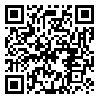BibTeX | RIS | EndNote | Medlars | ProCite | Reference Manager | RefWorks
Send citation to:
URL: http://journal.zums.ac.ir/article-1-2137-fa.html

 ، سولماز پیرانی
، سولماز پیرانی 
 ، فرناز برزی
، فرناز برزی 
 ، زهرا شجری*1
، زهرا شجری*1 

Background and Objective: Post-transplant diabetes mellitus (PTDM) is one of the problems occurring after kidney transplantation. This study was designed to detect the probable relationship between the glucose intolerance and serum and urinary concentrations of β2-microglobulin as well as their value to predict acute rejection of the transplant. Materials and Methods: In this cohort study, 40 patients without previous history of diabetes mellitus were enrolled serially. The glucose tolerance test and measurement of urinary and serum concentration of β2-microglobulin were done for all cases on days 3, 7, 11, and 21 after kidney transplantation. The relationship between short-term prognoses of the transplantation with blood glucose was analyzed by odd٬s ratio and correlations were also calculated. Results: Acute rejection of renal transplant was detected in 10% of the participants. At the third day after transplantation the rate of DM in subjects with and without transplant rejection was 75% and 35%, respectively (odd's ratio: 1.9, CI 95%: 0.2-20, p=0.09(. The rate of DM declined and reached to zero 21 days after the transplantation. There was a significant correlation between post glucose blood sugar concentration on day 3 and creatinine concentration on day 22 after the transplantation, which did not remain significant after adjustment for age. However, the significant correlation between the urine concentration of β2-microglobulin on day 11 after transplantation, and serum creatinine on day 21 remained constant after adjustments for age and sex. In the patients with transplant rejection, serum level of β2-microglobulin increased about four days before rises of creatinine. We did not find any correlation between blood glucose and β2-microglobulin concentrations. Conclusion: High incidence of post-transplantation glucose intolerance and DM was found after kidney transplantation especially at the first week after the transplantation. But we couldn’t find any relationship between post transplant diabetes mellitus (PTDM) and short-term prognosis of the kidney transplant.
دریافت: 1392/2/18 | پذیرش: 1392/2/19 | انتشار: 1392/2/19
| بازنشر اطلاعات | |
 |
این مقاله تحت شرایط Creative Commons Attribution-NonCommercial 4.0 International License قابل بازنشر است. |


